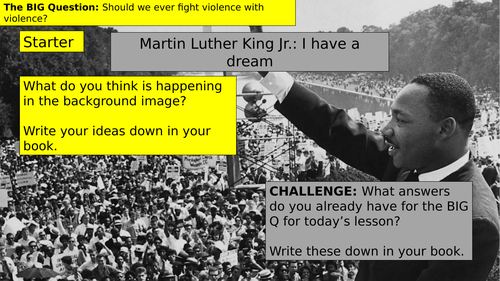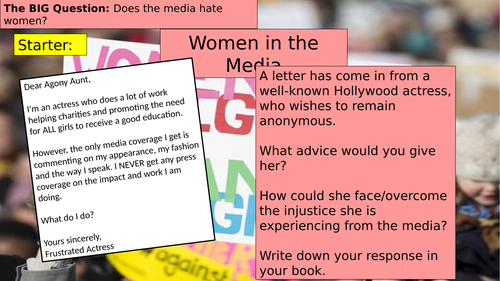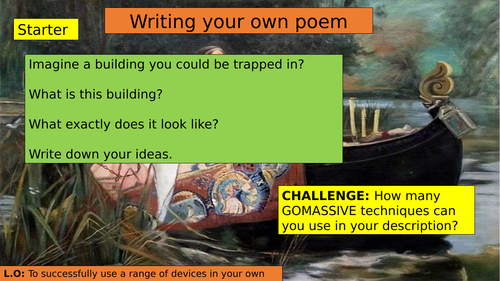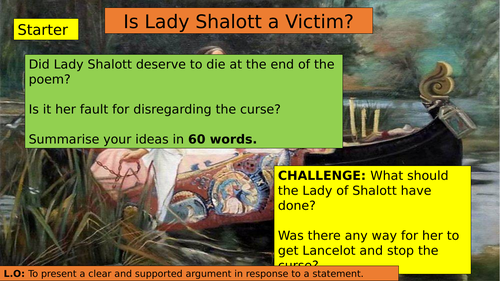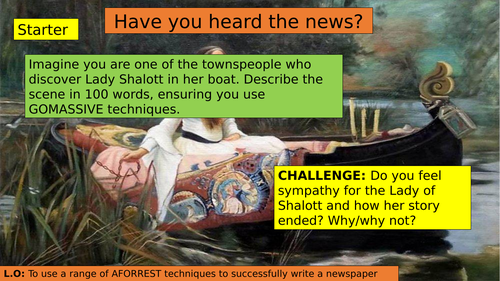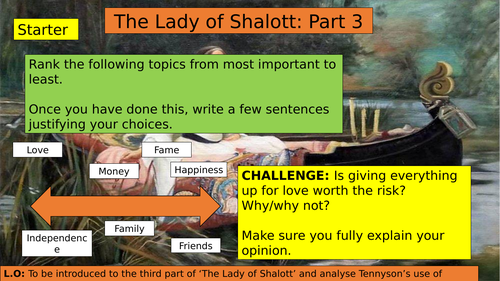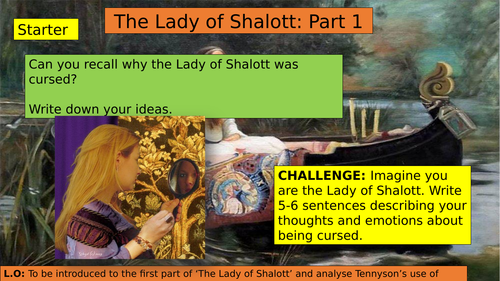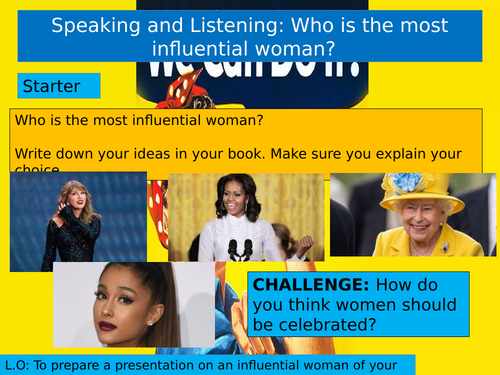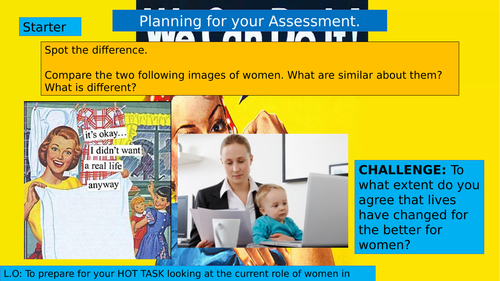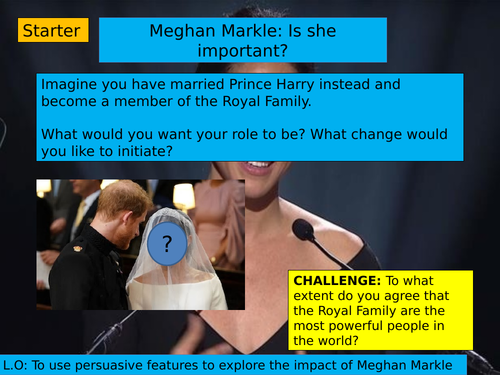60Uploads
18k+Views
4k+Downloads
All resources

Romeo and Juliet: Annotated (KS4)
I have created a booklet of 12 key scenes from Romeo and Juliet. These are:
The Prologue
Act 1, Scene 1: Sampson and Gregory
Act 1, Scene 1: Romeo and Benvolio
Act 1, Scene 2
Act 1, Scene 3
Act 1, Scene 5/ Act 2, Scene 2: Balcony Scene
Act 1, Scene 2: Romeo and Friar Lawrence
Act 3, Scene 1
Act 3, Scene 5
Act 4, Scene 3
Act 5, Scene 1
Act 5, Scene 3
The booklet contains extracts from each of these scenes and they are annotated by hand. Annotations include: terminology, analysis and contextual links.
This booklet could be used by the teacher, or as a resource for either revision, intervention or for students who may join later in a school year and have not studied the play.

KS3 (7/8/9) Writing a speech against injustice
This is a lesson planned for a high-ability Year 7 class looking at injustice. Pupils will write a speech persuading an audience to fight against injustice. There will be activities supporting them in creating arguments and embedding language techniques. The final activity will require students to write their speech and there are sentence starters included to support those who may struggle to start. This lesson is easily adaptable for any KS3 class of any ability.

KS3 (7/8/9) Martin Luther King's 'I have a dream' speech
This is a lesson planned for a high-ability Year 7 class looking at injustice and analysing sections of the ‘I have a dream’ speech.There will be activities supporting them in picking out key quotes and language devices, before discussing these. Students will then focus on how to pick quotes apart and analyse these in detail, with examples to help. The final activity will require students to write an analytical paragraph exploring how the language used makes the speech persuasive. This lesson is easily adaptable for any KS3 class of any ability.

KS3 (7/8/9) Speech on Women in the media
This is a lesson planned for a high-ability Year 7 class looking at injustice and how women are treated by the media. Pupils will write a speech arguing that women either are and aren’t fairly presented by the media. There will be activities supporting them in creating arguments and embedding language techniques. The final activity will require students to write their speech and there are sentence starters included to support those who may struggle to start. This lesson is easily adaptable for any KS3 class of any ability.

KS3 (7/8/9) Women in the media
This is a lesson planned for a high-ability Year 7 class looking at injustice and how women are treated by the media. Pupils will look at an array of famous women and look at newspaper articles comparing their treatment. There will be activities supporting them in picking out key quotes and language devices, before discussing these. Students will then focus on the different representations of Kate Middleton and Meghan Markle in the media. The final activity will require students to write an analytical paragraph exploring how the language represents the women. This lesson is easily adaptable for any KS3 class of any ability.
Bundle

KS3 (7/8/9) The Lady of Shalott Bundle
This bundle consists of 13 lessons worth of analytical and creative writing activities exploring the poem ‘The Lady of Shalott’ by Alfred Lord Tennyson. The lessons include activities supporting with selecting quote, identifiying language techniques and analysing quotes in more detail. In this bundle, there are also creative writing activities and opportunities for students to create diary entries and newspaper articles based on their studies. There are two assessments included in this bundle too where pupils will write analytical paragraphs about how Lady Shalott is presented, to track progress throughout this SOW.
ALL WORKSHEETS NEEDED ARE AT THE END OF EACH RELEVANT POWERPOINT.

KS3 (7/8/9) Writing a poem inspired by 'The Lady of Shalott'
This is a lesson planned for a high-ability Year 7 class. The lesson focuses on students writing their own poem, based on their studies of the poem of ‘The Lady of Shalott’ and aims to ensure that pupils understand the language techniques and structure that can be used in a poem. There is an activity supporting pupils in planning key language device, with a planning sheet included. This lesson is easily adaptable for any KS3 class of any ability.

KS3 (7/8/9) The Lady of Shalott Final Assessment
These are two lessons planned for a high-ability Year 7 class. The lessons focus on the whole ‘The Lady of Shalott’ poem and aims to ensure that pupils understand the language used by Tennyson to present the character of Lady Shalott. There is an activity supporting pupils in picking out key language devices and quotes. There is also support with sentence starters and a guide on how to use the PEACE structure for their paragraphs. This lesson is easily adaptable for any KS3 class of any ability.

KS3 (7/8/9) The Lady of Shalott: To what extent do you agree?
This is a lesson planned for a high-ability Year 7 class. The lesson focuses on the poem of ‘The Lady of Shalott’ and aims to ensure that pupils can explore both sides of the argument as to whether the Lady Shalott is a victim in the poem. There is an activity supporting pupils in picking out key language devices and turning these into agree and disagree points, with examples. There is then an activity supporting pupils in writing analytical paragraphs with a model paragraph to help. This lesson is easily adaptable for any KS3 class of any ability.

KS3 (7/8/9) The Lady of Shalott Newspaper Article
This is a lesson planned for a high-ability Year 7 class. The lesson focuses on reporting and consolidating the events in the poem of ‘The Lady of Shalott’ and aims to ensure that pupils understand the key events, as well as how to embed AFORREST techniques and how to structure a newspaper article. There is an activity supporting pupils in planning their language devices. This lesson is easily adaptable for any KS3 class of any ability.

KS3 (7/8/9) The Lady of Shalott Part Four
This is a lesson planned for a high-ability Year 7 class. The lesson focuses on part four of the poem of ‘The Lady of Shalott’ and aims to ensure that pupils understand the language used by Tennyson to create atmosphere. There is an activity supporting pupils in picking out key language devices. There is then an activity supporting pupils in writing analytical paragraphs on the first section using the PEACE structure and a model paragraph. This lesson is easily adaptable for any KS3 class of any ability.

KS3 (7/8/9) The Lady of Shalott Diary Entry
This is a lesson planned for a high-ability Year 7 class. The lesson focuses on Lady Shalott’s first glance of Sir Lancelot in the poem ‘The Lady of Shalott’ and aims to ensure that pupils understand how to embed a range of GOMASSIVE techniques into their creative writing. There are activities supporting pupils in improving their vocabulary and planning GOMASSIVE techniques to use. There is then an activity supporting pupils in writing their diary entry using a model text. This lesson is easily adaptable for any KS3 class of any ability.

KS3 (7/8/9) The Lady of Shalott Part Three
This is a lesson planned for a high-ability Year 7 class. The lesson focuses on part three of the poem of ‘The Lady of Shalott’ and aims to ensure that pupils understand the language used by Tennyson to introduce Sir Lancelot. There is an activity supporting pupils in picking out key language devices. There is then an activity supporting pupils in writing analytical paragraphs on the first section using the PEACE structure and a model paragraph. This lesson is easily adaptable for any KS3 class of any ability.

KS3 (7/8/9) The Lady of Shalott Part Two
This is a series of lessons planned for a high-ability Year 7 class. The lessons focus on part two of the poem of ‘The Lady of Shalott’ and aims to ensure that pupils understand the language used by Tennyson to establish setting and the character of Lady Shalott. There are activities including creative writing, supporting pupils in picking out key language devices and how to analyse these in detail. There is then an extended writing activity supporting pupils in writing analytical paragraphs on the second section. This lesson is easily adaptable for any KS3 class of any ability.

KS3 (7/8/9) The Lady of Shalott Part One
This is a lesson planned for a high-ability Year 7 class. The lesson focuses on part one of the poem of ‘The Lady of Shalott’ and aims to ensure that pupils understand the language used by Tennyson to introduce the setting and Lady Shalott. There is an activity supporting pupils in picking out key language devices. There is then an activity supporting pupils in writing analytical paragraphs on the first section using the PEACE structure. This lesson is easily adaptable for any KS3 class of any ability.

KS3 (7/8/9) Introduction of the Lady of Shalott
This is a lesson planned for a high-ability Year 7 class. The lesson introduces them to the poem of ‘The Lady of Shalott’ and aims to ensure that pupils understand the plot of the poem and the legend it is based on. A copy of the poem is also attached and the lesson allows pupils to look at Camelot and the Legend of King Arthur. There is also a youtube link attached to a slide so pupils can read along with a spoken performance of the poem. Pupils then have an activity of making their own storyboard, selecting 8 key scenes. This lesson is easily adaptable for any KS3 class of any ability.
Bundle

(KS3 7/8/9) Women in Society SCHEME OF WORK
This is a bundle of an entire scheme of work focusing on women in society and how they are presented. This was planned for a middle-ability Year 8 class but can easily be adapted for any KS3 class of any ability. The scheme of work starts with an opening assessment getting pupils to write an argument about the role of women, before exploring how women have been presented in classical literature and modern society.

Women in Society Speaking and Listening
These are a series of lessons planned for a middle-ability Year 8 class looking at who they think the most influential woman is. Pupils will research an individual of their choice and create a speech (perhaps a powerpoint too) on why their chosen individual deserves to win the award for ‘Greatest modern-day female contributor’. This lesson is easily adaptable for any KS3 class of any ability.

Women in Society Final Assessment
This is a lesson planned for a middle-ability Year 8 class looking at writing a persuasive speech giving a clear argument in response to a statement. Pupils will debate how important equal rights are and there are activities and a worksheet to help them plan their speech. There is then a success criteria and sentence starters to support them in writing their speech. This lesson is easily adaptable for any KS3 class of any ability.

(KS3 7/8/9) Meghan Markle's Impact
This is a lesson planned for a middle-ability Year 8 class looking at the impact of Meghan Markle. Pupils will debate the impact she has had so far before considering writing a newspaper article persuading the audience that she has or hasn’t made a significant impact. There is support provided to help pupils with writing with a catchy headline activity and sentence starters. This lesson is easily adaptable for any KS3 class of any ability.



